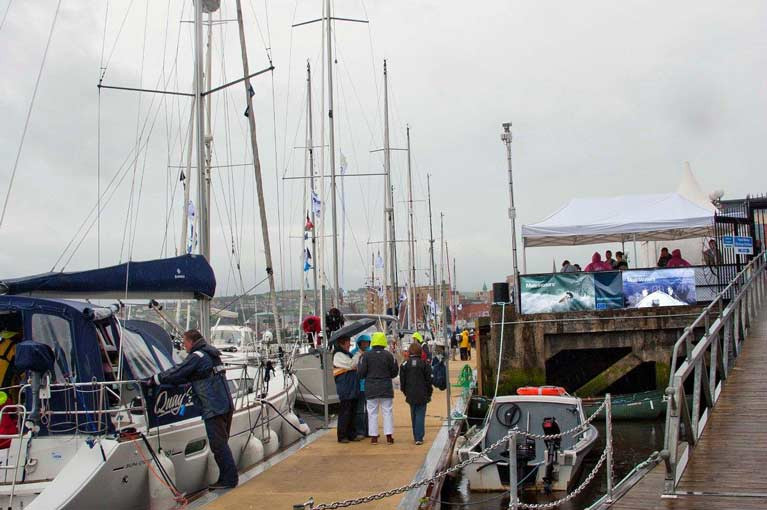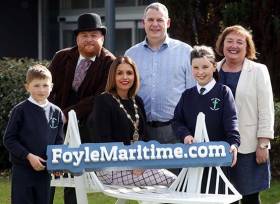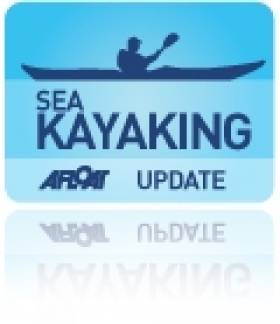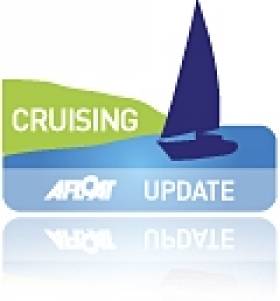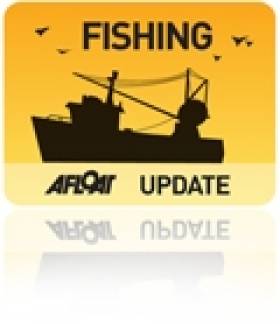Displaying items by tag: foyle
Foyle & Carlingford Anglers Urged to Make 2020 Catch Returns to Support Scientific Research
The Loughs Agency is reminding anglers in the Foyle and Carlingford areas to log and submit their angling effort, catches and releases for the 2020 season.
Rod licences for salmon and sea trout in Foyle and Carlingford come with a legal obligation to inform the Loughs Agency (via the eLicence web portal) of how many times the licence holder went fishing and got many fish they caught.
To date, the agency says less fewer than 10% of anglers have made their return for the 2020 season.
For the 2020 season, the Loughs Agency will be carrying out an in-depth study of catch returns and angling effort to determine fish runs in rivers, number of fish caught, weight of fish caught and/or released, and how much time anglers put into catching those fish.
As a result, anglers are encouraged to make their return and be as accurate as possible with locations, dates, weights, species, methods and time spent fishing.
The deadline for catch returns is Thursday 21 January 2021.
Foyle Port Marina in the North West of Ireland is now open to visitors; however, the self-Isolating restrictions introduced on Monday 8th June by the Government will apply to vessels visiting from outside the UK and Ireland.
These can be found here
The Marina lies in the heart of the City of Derry and is 17 miles from the mouth of Lough Foyle. The passage through Lough Foyle has spectacular views of the Donegal hills on the north side and the cultivated flatlands south of Magilligan Point on the other. The marina is accessed via a well-marked navigation channel from the Atlantic leading right into the city. This is also used by large ships accessing and leaving the commercial port at Lisahally.
The marina consists of two pontoons, one a 200m long wooden structure and 140m concrete structure offering in excess of 600mtrs of secure deep water berthing. You can book a berth here
The Marina would have been the hub of next month’s Maritime Festival and Clipper Race stop-over but sadly they have fallen foul of COVID 19 as Afloat.ie reported on 27th March here.
Permits Now Available For Loughs Agency Fisheries
As of yesterday (Tuesday 19 May), permits are available for Loughs Agency permit waters on the River Foyle, River Finn (approx six miles) and Greenbraes Fishery.
DAERA has also opened, with limitations, the Public Angling Estate in Northern Ireland — which in the Foyle and Carlingford areas includes Loughbrickland, Binevenagh, Moor Lough, Lough Ash, Lough Bradan, Lough Lee and a section of the River Roe.
The Loughs Agency adds that angling clubs and private fisheries will decide how and when to open their waters.
It is for each club and fishery owner to decide if they can comply with government advice with regard to social distancing and hand hygiene.
Anglers are reminded that they also have individual responsibility to comply with UK and Irish government advice regarding social distancing, hand hygiene and travel restrictions.
The agency’s fisheries protection staff have returned to full-time duties with immediate effect and will continue to work in partnership with the PSNI and An Garda Síochána with regard to fisheries offences.
Game and coarse anglers are also reminded that to fish in the waters of Foyle and Carlingford they require a licence from Loughs Agency and a permit from whomever holds the fishing rights.
Loughs Agency licences are available online. Anglers should contact the fishery/angling club directly regarding permits that are not provided by Loughs Agency.
Foyle & Carlingford Anglers Encouraged To Make Catch Returns For 2019
Anglers are being encouraged by the Loughs Agency to log and submit their efforts, catches and releases for the 2019 angling season in Foyle and Carlingford.
Whenever anyone buys a rod licence to fish for salmon and sea trout in Foyle and Carlingford, they are legally obliged to let the Loughs Agency know if they have caught fish and how many times they went fishing.
This information can now be easily recorded through the loughs angling elicence website. Simply log in with your Angler Number and update your angling log for the 2019 season.
John McCartney, Lough Agency director of conservation and protection, said: “This is really important information because it enables our scientists to understand how many fish are caught, taken or returned back to the river and how much time anglers put into catching those fish.
“It provides an indication of how well stocks are doing and if we need to take any action should catches take a turn for the worst.”
Freshwater fishery biologist Mark McCauley advised that the data is used “to screen proposed developments such as roads, hydro, etc that may impact the interests of the fishery. We can also use the data anglers provide to assess the strength of fish runs in the system this year and also for long term trend monitoring.”
As reported last week on Afloat.ie, salmon and sea trout anglers in the Republic of Ireland have been reminded to return their 2019 logbooks and unused gill tags as soon as possible, even if there is no catch recorded.
Foyle Sailability Goes With the Flow
Following on from yesterday's Dun Laoghaire announcement of its Sailability programme the River Foyle in Derry has launched its fun introductory session as 'a fantastic opportunity for people with disabilities' to ‘Try Sailing’ for the first time and learn the basics. Taking place on Saturday 14th May at Foyle Marina this ‘have a go’ event is being offered for free and with no prior experience or specialist equipment required there really is no excuse not to give it a try!
Foyle Sailability exists to bring the joy of sailing and boating to people with disabilities from across the North West region of Ireland, says chairperson Cathal MacElhatton. “Operating from the Foyle Marina, which has a hoist, we have a range of accessible dinghies for everyone to enjoy out on Lough Foyle. Our aim is to provide safe and enjoyable sailing opportunities to people with disabilities interested in experiencing the sport of sailing and other ‘on the water’ activities”.
“On arrival you will be kitted out with all the necessary equipment and given a safety briefing and introduction, then it will be time to get into your boats and get sailing! Our qualified instructors will be in the boat along with you to help throughout the session and provide any tips on improving your technique. “
The event runs from 10.30am to 3pm and is divided into short sessions, so early booking from [email protected] is advised, although it’s free, advises Cathal. Foyle Marina is located at Baronet Street.
Foyle Sailability is offering this taster event as part of a national campaign called ‘Flow – Get into Watersports’ which is co-funded by The Erasmus Plus programme of the European Union and is a partnership between SportNI and a range of water based National Governing Bodies with the aim of encouraging more people to participate in watersports. The campaign kicks off with a weekend of water based outdoor activity taster events all over Northern Ireland during the weekend of 14th and 15th May. These events will be closely followed by a series of follow up training programmes to encourage people to continue in their chosen activity. So even if you can’t attend the taster events you can still get involved by taking part in one of the follow up training programmes that are taking place.
During the weekend there will be a range of clubs based all over Northern Ireland offering taster events in canoeing, sailing, water skiing and wake boarding, rowing, angling, stand up paddle boarding and diving.
SportNI is one of the leading organisations behind the initiative and their Outdoor Recreation Development Officer, Mike McClure, believes it is a great way for people to get into a water sport and to eventually join a club by commenting “Flow is a wonderful way for people to experience the great natural water resources we have here in Northern Ireland and hopefully by taking part in this campaign it will help develop favourite past-times that participants will take part in for many years to come”.
Visit www.FlowNI.com to see a full list of taster events and follow up training programmes that are being offered as part of the campaign to get you flowing into your next adventure!
Foyle Maritime Festival Stages Schools Competition
Primary schools across the Derry City and Strabane District Council area are being invited to take part in an exciting free education outreach programme that will allow them to explore their maritime heritage through an innovative and interactive programme entitled: “DuPont Float Your Boat.”
The education programme is being run by the Derry City and Strabane District Council in partnership with DuPont ahead of the forthcoming Foyle Maritime Festival that is taking place from 09-17 July when the Clipper Round the World Race yachts will make a welcome return to the city for a fun filled festival of fun and celebration.
The education programme will be delivered by Footsteps Interpretation and is being held alongside a competition encouraging students to design their own model boat and be in with a chance of their design being exhibited during the Maritime Festival in July.
Mayor of Derry City and Strabane District Council, Cllr Elisha McCallion says the education programme is a fantastic way of getting primary school children from across the city and district involved in the festival and encouraging them to explore and appreciate their local environment and their close proximity to maritime heritage.
“What I really like about this education programme is that it is all about fun and getting the children involved in a way that encourages them to take a real interest in the topics covered. It is very interactive and creative and encourages them to use their imagination and come up with creative ideas and concepts. I am delighted that we have DuPont on board as our main sponsor for the festival and look forward to working with them on the festival,” she said.
Paul Kirkpatrick, Organisation Manager, DuPont, said: “We’re so pleased to be working with the Derry City and Strabane District Council to deliver a fun, engaging and free education programme to primary school children from across Derry~Londonderry. As a company, we regularly reach out to schools, offering prizes for STEM (science, technology, engineering, mathematics) related tasks as well as creating our own competitions, so we are constantly engaging with young minds and hopefully inspiring them to take more of an interest in engineering.
“At DuPont we make Kevlar® which is extraordinarily strong, lightweight and on an equal-weight basis, five times stronger than steel. It is best known for its use in protective garments but it can also be found in ships’ hulls and we’ll all get a chance to see many of those when the Foyle Maritime Festival kicks off.”
Margaret Edwards, Education Officer with Derry City and Strabane District Council explained that the DuPont Float Your Boat scheme covers a number of areas to ensure the children get a good overview.
“Among the themes of the education project is Maritime Heritage, where the children will be encouraged to discover about the region’s maritime past, get the chance to meet with 18th century ship builder characters to hear stories of ship building, the port and navigation. Under the Environment Significance of the Region theme, the children will find out more about the environmental importance of Lough Foyle and its surrounding rivers and discover how some animals use internal navigation to travel great distances to return to their local environment. And as part of the Clipper Round the World Race theme they will hear at first-hand about life on board a Clipper yacht,” she said.
She added that the education programme meets a number of learning areas and skills for both the NI and RoI curriculum and features a learning pack for teachers.
The students are also being encouraged to participate in a competition to build their own model boat using recyclable materials. The top three designs will receive an individual prize and will be on display alongside six highly commended designs during the Foyle Maritime Festival in July.
Full details of the Foyle Maritime Festival are to be launched at the end of April.
Big GP14 Turnout for Lough Foyle's Culmore Regatta
Culmore Regatta saw an exceptionally large turnout of GP14 boats and Foyle Class Punts. Winds were good for the Dinghy races but fell away for the Foyle Class punts.
Winners for the Foyle Class punts ;
Billy Doherty Memorial Cup was won by Roy Louden with Ryan Louden and James Lynch as his crew.
Bill McCann won the Isaac Ayton Cup for Foyle Class Punts with his crew of Danny McCann and Mark Banks.
The third Foyle Class Punt race was Won By Daniel Gallagher with his crew of Gareth Gallagher and Owen McCauley.
The Dinghy races – The first Race for the Magnet Trophy was won by Gareth Gallagher and Richard Gallagher , with Ken and Stuart Doherty second and Peter Fallon and James P Hockley third .
The second Dinghy race for the Frank Long Cup was won by Gareth and Richard Gallagher, second Pater Fallon and James P Hockley, third was John and Donal McGuiness.
26 Canoeists Rescued From River Foyle
#foylerescue – A group of canoeiests are safe after capsizing on the river Foyle this afternoon and sparking a major resuce operation. At 2.05pm Belfast Coastguard was alerted by Police Service Northern Ireland, (PSNI) to an incident in the River Foyle involving two large capsized canoes with 26 people in the water.
Coleraine Coastguard Rescue Team was sent to the area and the Coastguard requested lifeboats from Foyle Search & Rescue, the Irish Coastguard rescue helicopter and Irish Coastguard boat from Greencastle. Northern Ireland Fire & Rescue Service also joined the search and rescue operation.
Lifeboats recovered 26 adults from the water and 12 people were transferred to hospital by helicopter and also by Northern Ireland Ambulance Service to be checked for hypothermia.
The group of 26 adults had got into difficulty after their two large canoes capsized.
The canoeists were taking part in a fundraiser for the YMCA. All 26 are now at Altnagelvin hospital with mild hypothermia, it has been reported.
The Coastguard recommends:
Safety Advice for Sea canoeing / kayaking: Ensure that someone at home knows your passage plan including points of arrival and departure, timescale, number in group and other relevant information. Check weather forecasts and tidal conditions and ensure that your skill levels are appropriate for where you are kayaking. Wear a buoyancy aid and check that equipment is functioning properly, that your distress flares are in date and are stowed where you can reach them. Carriage of a 406 Personal Locator Beacon is highly recommended for more remote locations.
Carry a VHF marine band radio (fitted with DSC if possible) and learn how to use it. Where there is good network coverage then it is worth carrying a mobile phone in a waterproof bag. Call the Coastguard if you get into difficulty, preferably via channel 16 on your radio or if not by calling 999 and asking for the Coastguard.
Sail Ireland's North–West Coast to Derry
#visitderry – Sail Ireland's North West and discover Donegal's rugged coastline and the River Foyle to the walled city of Derry~Londonderry, named by 'Lonely Planet' as one of the Top 10 Cities to visit in the World!
Follow the seaways from Scotland, England and Wales and, with good planning, the tidal streams will make light work of the passage across the North Channel and westward to the Foyle. Lying in wait is the fantastic coastline of Inishowen, with vistas of towering stacks, cliffs, beaches and a repertoire of heritage!
Sailing along the top of Ireland, take advantage of the sheltered delights of Lough Foyle and, at its mouth, the quaint village of Greencastle, the second-biggest fishing port in Donegal.
The harbour accommodates a wide range of yachts and a new permanent pontoon is planned for 2015. Trawlers from here ply as far as Rockall and the local mussel and oyster harvests supply restaurants across the region. Greencastle itself is home to a superb seafood eatery and its traditional Irish pubs are perfect places to relax and enjoy the 'craic' in this friendly village.
Visitors can also avail of a stunning shoreside walk and check out the Inishowen Maritime Museum – housed in the Coastguard buildings overlooking the harbour. Lough Foyle is shallow but a well-marked shipping channel runs all the way from Greencastle to Derry~ Londonderry's Foyle Marina, where two pontoons can berth up to 120 boats.
Named by acclaimed travel publication 'Lonely Planet' as a Top 10 City in the World, Derry is renowned as one of the finest walled cities in Europe and the defences celebrated their 400th anniversary in 2013 during Derry's iconic year as the inaugural UK City of Culture.
Take a trip back in time strolling along the famous 17th Century walls, and view one of the largest collections of original cannon in Europe, dating back to the days of the Siege. Or why not call in to one of the many museums and immerse yourself in the city's quirky history?
A hard day shopping and sightseeing is guaranteed to work up an appetite and whether you're looking for contemporary cuisine, a fine dining experience or somewhere to re-fuel the kids, you'll find it all here.
So where to next? Derry is home to a thriving music scene and the city is packed with lively bars, stylish clubs and traditional pubs.
Join the locals in an Irish trad 'seisiun' or catch a gig at one of Derry's cutting-edge music venues. Or why not check out one of the city's many events? Visit Derry recommends the City of Derry Jazz from April 30 to May 1 (cityofderryjazzfestival.com), and Flavours of the Foyle Seafood Festival (25-26 July).
Just minutes from Derry lies the stunning landscape of Donegal. Take a drive around its rugged coastline and marvel at endless beaches, medieval castles and natural wildlife. Challenge yourself and try your hand at angling, cycling, hiking or surfing. And let's not forget some of Ireland's finest links courses!
To the east of the city you will find the stunning natural hinterland of the North Antrim Coast. Explore the Giant's Causeway, a UNESCO World Heritage Site, and take an 'Indiana Jones' style walk across the famous Carrick-A-Rede rope bridge, which is suspended over 100ft between two rugged cliffs – an experience that is definitely not for the faint hearted!
To finish your day, call into Bushmills Distillery for a drop of Northern Ireland's most famous exports, Bushmills whiskey.
On the doorstep of such stunning scenery, Derry~ Londonderry has to be one of Europe's greatest city experiences. With berthing fees from just £15 per night there really is no better time to visit. Make your next sail the North West of Ireland – it'll be 'LegenDerry'!
'The North West is among the most beautiful cruising grounds in the world'
During the Clipper Round the World Yacht Race, the Derry~Londonderry stop–over was the best; not just from my slightly biased point of view, but also one shared by most of the crew on the other boats. The reception after the scenic trip up the Foyle into such a vibrant and friendly city is what made it so special. The facilities in the new Foyle Marina and also nearby in Greencastle, Co Donegal are fantastic. It's great to see the development going into the port as it and the surrounding areas in the North West of Ireland are among the most beautiful cruising grounds in the world... especially when the sun shines!
Derry~Londonderry skipper Sean McCarter
DATE FOR YOUR DIARY!
The Clipper Round the World Yacht Race and Maritime Festival returns to the city – in Summer 2016!
Now firmly established as the No 1 stop–over destination on the Clipper Race circuit, Derry will host a week-long Maritime Festival to celebrate the arrival of this iconic race. Foyle Marina will transform into a summer promenade, complete with race village, marine marquees, award winning continental market and host of sea-faring activities on and off shore. At the centre of the festival will be the welcome of the 12-strong fleet of Clipper yachts, including Derry~Londonderry-Doire yacht. In 2014, the city welcomed more than 120 visiting yachts during the festival – make sure you are part of the celebrations next year!
Book your berth now!
Contact FOYLE Port
+44 (0) 28 7186 0555
Oyster Beds to Reopen On The Foyle
#oysters – Minister of State at the Department of Communications, Energy and Natural Resources, Joe McHugh T.D. and the North's Agriculture Minister Michelle O'Neill MLA, jointly welcomed the decision by the Loughs Agency to re-open two of the six main oyster fishing beds in Lough Foyle which had been closed for the last number of weeks.
Minister McHugh said: "The decision to partially re-open the beds from 15 to 19 December 2014 will create potential opportunity to catch up to an additional 25 tonnes (up to a value of €125,000). I believe that the Agency has achieved a good balance between economic opportunity for local fishermen with a dividend for the local communities and the conservation imperative".
He added "I want to emphasise that sustainability and safeguarding this natural resource in Lough Foyle are the shared responsibilities of all stakeholders, including the licensed fishermen."
Minister O'Neill said: "Whilst I appreciate the importance of Management interventions to conserve and maintain oyster stocks, I am mindful of the impact that closure of the oyster beds has had on the livelihood of local oystermen particularly in the run-up to Christmas.
"Looking to the future, I am hopeful that there will be constructive engagement between the Agency and local fishermen on a range of issues that will safeguard the future of the Native Oyster Fishery on Lough Foyle.
Ministers had jointly raised the issue of the closure of the oyster beds at the North South Ministerial Council Aquaculture and Marine Sectoral Meeting in Armagh last Friday when they asked the Agency to review its decision to close the main oyster beds.
The Ministers pointed out the need to strike a balance between the socio-economic benefits for the Foyle Oyster Fishermen and the scientific evidence to support the long term sustainability of the Native Oyster Fishery on Lough Foyle.
Both Ministers thanked the Chairman, Chief Executive and the Loughs Agency staff for efforts in reaching this decision.





























